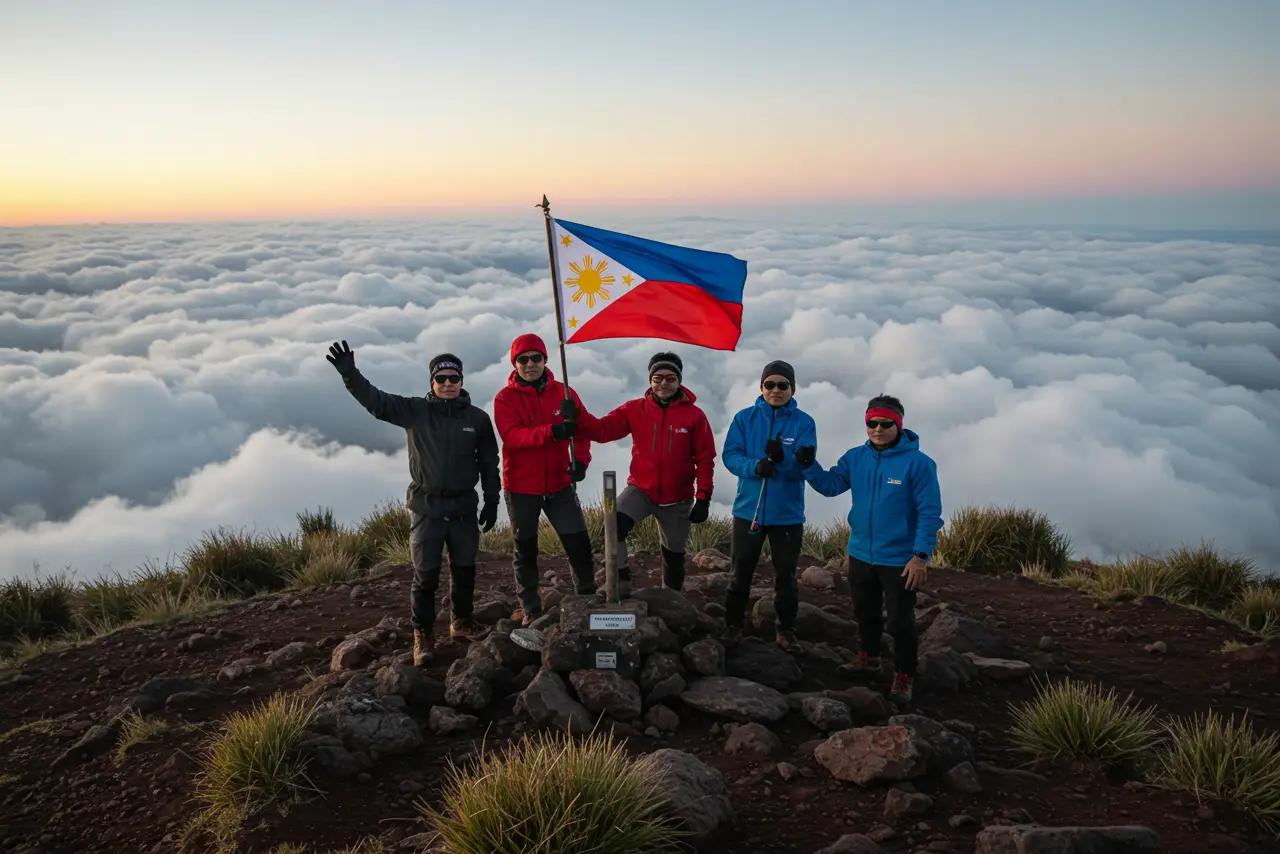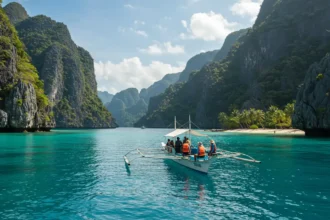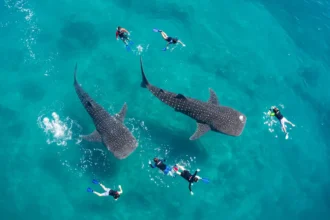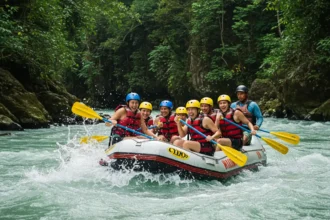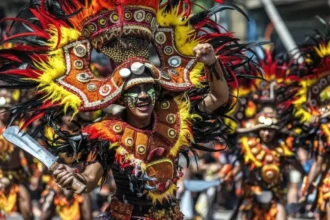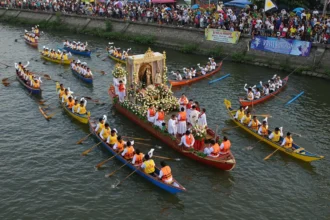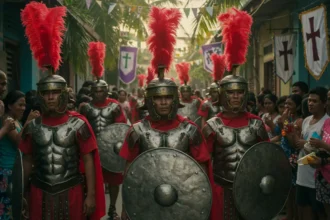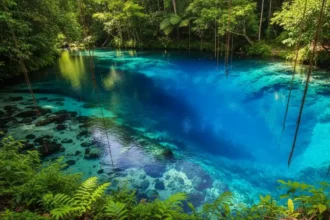They say you haven’t truly climbed the Philippines until you’ve stood at the top of Mount Apo — the Grandfather of Philippine Mountains. Rising 2,954 meters above sea level, it towers over Davao, Cotabato, and Kidapawan like a giant guarding Mindanao’s heart.
- 🗺️ 1. How to Get to Mount Apo – Access Points and Starting Locations
- 🥾 2. Trail Options – Which Mount Apo Route Fits You Best
- 💪 3. Training and Fitness Preparation for the Mount Apo Climb
- 🧾 4. Mount Apo Permits, Fees, and Required Guides
- 🎒 5. Packing List and Mount Apo Climb Essentials
- ⏰ 6. Sample Itinerary – What to Expect on the Trail
- 🌦️ 7. Best Time to Climb Mount Apo and Weather Tips
- ⚠️ 8. Safety Guidelines and Common Hazards on Mount Apo
- 💰 9. Budget Breakdown – Guided Tour vs. DIY Mount Apo Climb
- 🌱 10. Responsible Climbing – Leave No Trace on Mount Apo
- ❓ FAQs About Mount Apo Climb Guide for First-Timers
- 🌤️ Standing Tall at the Roof of the Philippines
Every year, hundreds of climbers — from seasoned mountaineers to curious first-timers — take on the challenge of conquering the highest peak in the Philippines. But Apo is no ordinary hike. It’s a test of endurance, patience, and respect for nature. Think river crossings, steep ascents, volcanic boulders, and long treks through dense rainforest — all leading to one unforgettable sunrise above the clouds.
Whether you’re joining a guided expedition or planning a DIY adventure, preparation is everything. From fitness training and permits to trail options and packing lists, this Mount Apo climb guide will walk you through each step to help you reach the summit safely — and enjoy the journey along the way.
So, handa ka na ba? Lace up your boots, charge your camera, and let’s climb the mountain that defines every Filipino hiker’s dream.
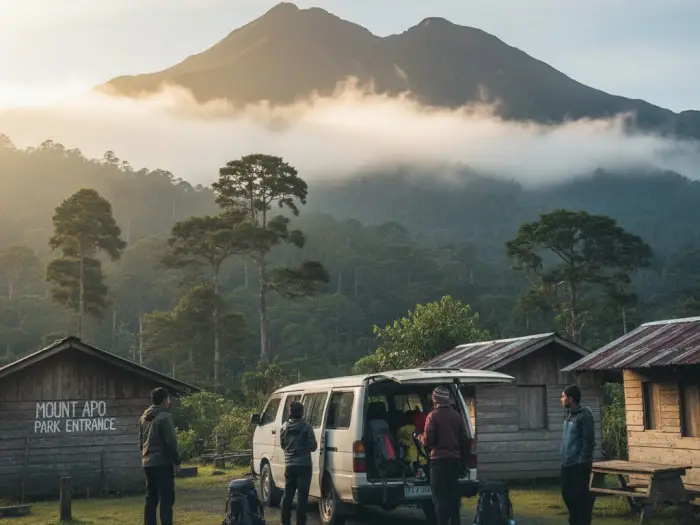
🗺️ 1. How to Get to Mount Apo – Access Points and Starting Locations
Mount Apo sits on the border of Davao del Sur and North Cotabato, making it accessible from several jump-off cities — Davao City, Digos, and Kidapawan. Each offers its own trail and travel convenience, depending on where you’re coming from.
🚍 From Manila or Other Major Cities
-
By Air: Fly to Davao International Airport (Francisco Bangoy Airport) — the main gateway to Mount Apo. Flights from Manila, Cebu, and Iloilo take 1.5–2 hours.
-
By Land (for Mindanao locals): Buses and vans regularly travel to Davao, Digos, or Kidapawan from General Santos, Cotabato, or Cagayan de Oro.
🏞️ Main Access Points and Jump-Off Cities
| Entry Point | Province | Nearest City / Trailhead | Travel Details |
|---|---|---|---|
| Davao City | Davao del Sur | Kapatagan Trail | 2–3 hours from Davao City by van or jeepney |
| Kidapawan | North Cotabato | Mandarangan Trail | 2–3 hours from Cotabato City or Davao |
| Digos City | Davao del Sur | Sibulan Trail | 1.5–2 hours from Davao City |
| Makilala | North Cotabato | Bongolanon Trail | 3 hours from Davao or Kidapawan |
🧭 Recommended Route for First-Timers
Most beginners take the Kapatagan–Sibulan route, accessible from Davao City. It’s scenic, well-established, and popular among guided tours. Expect forest trekking, boulder fields, and sulfur vents along the way.
💡 Traveler’s Move
If you’re flying in, arrive in Davao a day early to buy supplies at Gaisano or Abreeza Mall, and get a good night’s rest before your climb. Altitude, cold, and long walks are no joke — a fresh body makes a world of difference.
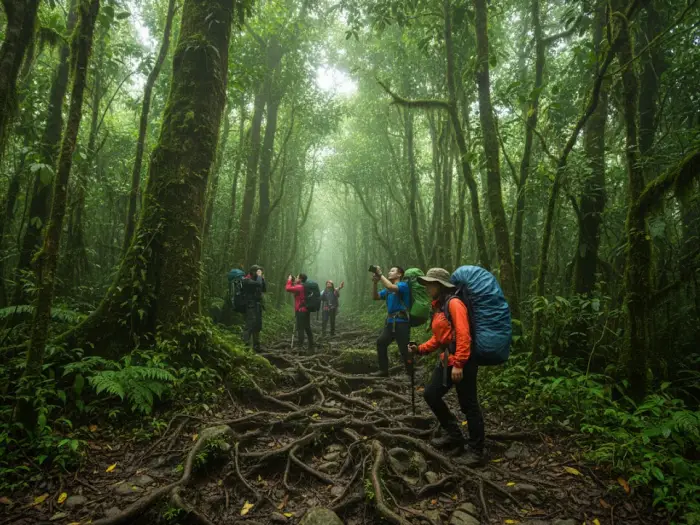
🥾 2. Trail Options – Which Mount Apo Route Fits You Best
Mount Apo isn’t a one-path mountain — it has several major trails that cater to different hiking styles. Some are scenic, some brutal, and a few feel like an expedition. Choosing the right one depends on your fitness, time, and appetite for challenge.
Kapatagan Trail (Digos City)
This is the most popular and beginner-friendly trail. It passes through farmlands, mossy forests, and the famous Boulders Section near the summit. The climb is steady but not overly technical, making it ideal for those joining organized tours.
-
Difficulty: 6/9 (moderate to hard)
-
Duration: 2–3 days
-
Highlights: Lake Venado campsite, sulfur vents, wide summit view
-
Best for: First-timers with good endurance
Sibulan Trail (Sta. Cruz, Davao del Sur)
Often combined with Kapatagan for traverse climbs, this route is slightly tougher and longer but offers stunning scenery and fewer crowds.
-
Difficulty: 7/9 (challenging)
-
Duration: 3–4 days
-
Highlights: Mossy forest, river crossings, geothermal vents
-
Best for: Fit hikers looking for variety
Kidapawan Trail (North Cotabato)
The original trail to Apo’s summit, famous for its dense jungle, waterfalls, and the vast Lake Venado at 2,200 meters. It’s humid and steep in parts, but rich in biodiversity.
-
Difficulty: 7/9 (hard)
-
Duration: 3 days
-
Highlights: Forest trek, lake campsite, views of Mount Matutum
-
Best for: Adventurous hikers who like classic routes
Bongolanon Trail (Makilala)
One of the lesser-used routes, offering a more remote experience. Expect muddy terrain and long hours of trekking through thick forest.
-
Difficulty: 8/9 (very hard)
-
Duration: 4 days
-
Highlights: Untouched jungle, solitude, panoramic summit ridge
-
Best for: Experienced trekkers and private expeditions
| Trail | Difficulty | Duration | Notable Feature |
|---|---|---|---|
| Kapatagan | Moderate | 2–3 days | Boulders & Lake Venado |
| Sibulan | Hard | 3–4 days | River crossings |
| Kidapawan | Hard | 3 days | Forests & waterfalls |
| Bongolanon | Very hard | 4 days | Remote wilderness |
Traveler’s Move
If it’s your first Mount Apo climb, take the Kapatagan–Kidapawan traverse. You’ll experience both landscapes — the iconic boulder ascent and the lush forest descent — without overexerting on just one side.
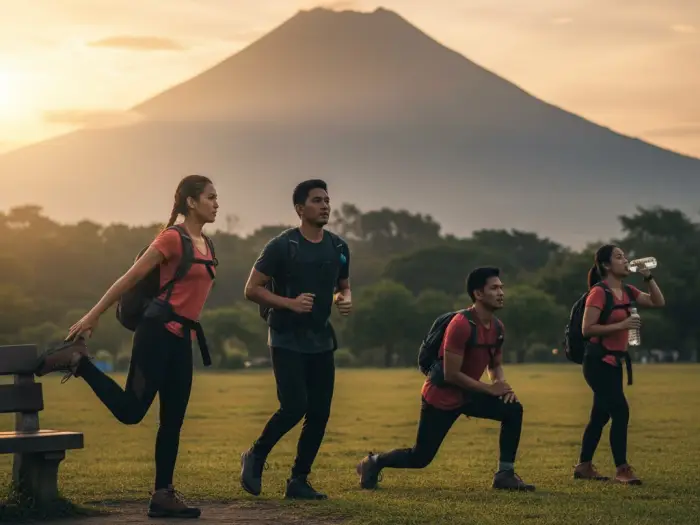
💪 3. Training and Fitness Preparation for the Mount Apo Climb
Climbing Mount Apo isn’t just a weekend stroll — it’s a physical and mental challenge that demands real preparation. At nearly 3,000 meters high, the air thins, the trail gets rough, and your endurance is constantly tested. That’s why training at least a month before the climb is a must, especially for first-timers.
Build Your Endurance
Start with cardio workouts like brisk walking, jogging, or stair climbing three to four times a week. Aim for at least 5–10 kilometers per session. If you live near hilly areas or have access to a treadmill incline, use it — the steeper, the better.
Strengthen Your Core and Legs
Mount Apo’s boulder section will test your leg power. Add squats, lunges, planks, and step-ups to your weekly routine. Strengthening your knees and ankles helps you handle steep, uneven ground without injury.
Practice with Shorter Hikes
If possible, do a few training climbs before tackling Apo. Great warm-up hikes include Mount Batulao (Batangas), Mount Ulap (Benguet), or Mount Pulag’s Ambangeg Trail. These will help you test your stamina and gear before the real deal.
Train Your Breathing
The air at high altitude feels thinner, especially near the summit. Practice steady breathing and pacing — walk slowly but consistently. Avoid sprinting at the start; save your energy for the long ascents on day two.
Mindset Matters
Mental endurance counts as much as physical strength. There will be moments when you’re cold, tired, and tempted to give up. Stay positive, rest when needed, and remember: every climber moves at their own pace — there’s no shame in taking it slow.
Traveler’s Move
If you can, carry a 10–12 kg backpack during training walks. It simulates real conditions and helps your body adjust to the load you’ll carry during the actual climb.
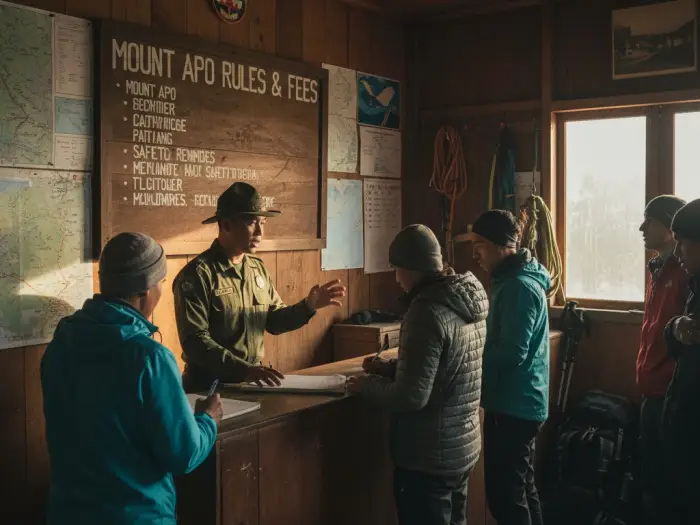
🧾 4. Mount Apo Permits, Fees, and Required Guides
Before setting foot on Mount Apo, every climber must secure the necessary permits and hire a local guide — these are non-negotiable. The mountain is a protected natural park and a sacred ground for the indigenous Bagobo, Manobo, and K’lagan tribes, so respect and compliance are key.
Where to Get Your Climb Permit
Permits are issued by the Mount Apo Natural Park – Protected Area Management Board (MANP-PAMB). You can apply through accredited tour operators or directly at the DENR office in Davao or Kidapawan.
For independent hikers, it’s best to coordinate weeks in advance since the park limits the number of climbers per day to preserve the ecosystem.
Updated Fees (as of 2025)
| Fee Type | Estimated Cost (₱) | Details |
|---|---|---|
| Climbing Permit | 500–800 | Includes environmental and conservation fees |
| Guide Fee | 1,000–1,500 per day | Required (ratio: 1 guide per 5 hikers) |
| Porter Fee | 800–1,000 per day | Optional, depends on load |
| Camping Fee | 100 per night | Collected at campsite checkpoints |
| Exit Fee (for traverse climbs) | 200 | Applies if exiting at a different trail |
Guides and porters can be arranged through local tourism offices or your chosen trail’s entry point (Kapatagan, Kidapawan, Sibulan, etc.).
Orientation and Briefing
Before the climb, all hikers must attend a short orientation session covering safety protocols, environmental rules, and cultural do’s and don’ts. Here you’ll also sign a waiver and confirm your registered route.
Important Reminders
-
Permits are non-transferable — always bring a valid ID.
-
No permit, no climb policy is strictly enforced at checkpoints.
-
If weather conditions worsen, park authorities can postpone or cancel climbs for safety.
Traveler’s Move
Book your slot at least one month ahead, especially during Holy Week or dry season (February to April). Climb schedules fill fast, and walk-in permits are rarely available.
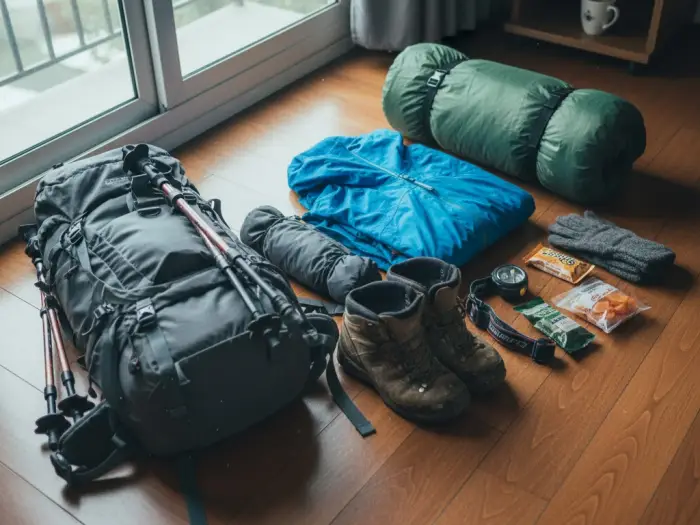
🎒 5. Packing List and Mount Apo Climb Essentials
Climbing Mount Apo means facing everything from tropical humidity to freezing winds near the summit. The rule is simple: pack light, but pack smart. Every extra kilo counts when you’re hauling your bag across boulders and steep forest trails.
Basic Gear and Equipment
| Item | Purpose / Notes |
|---|---|
| Backpack (45–60L) | Main pack; should have a rain cover |
| Tent (3-season) | Weatherproof; shared or personal tent |
| Sleeping bag (0°C rated) | Essential for summit nights |
| Sleeping mat | Insulates you from cold, damp ground |
| Trekking shoes or boots | Waterproof with good ankle support |
| Trekking poles | Helps during long ascents and descents |
| Headlamp or flashlight | Bring extra batteries |
| Water bottle or hydration bladder (2L) | Stay hydrated throughout the trek |
| Portable stove and butane | For cooking; bonfires are banned |
| Mess kit (plate, mug, spork) | Bring reusable, non-disposable items |
Clothing Checklist
Layering is key. Mount Apo’s weather can swing from sunny to shivering in a few hours.
-
Quick-dry shirt (avoid cotton)
-
Fleece or thermal jacket
-
Waterproof shell or windbreaker
-
Trek pants or leggings
-
Gloves, beanie, and scarf
-
2–3 pairs of thick socks
-
Extra dry clothes for sleeping
Food and Personal Items
-
Instant rice meals or canned food
-
Trail snacks (nuts, chocolate, dried fruit)
-
Hot drinks (coffee, salabat, Milo)
-
Toiletries and wet wipes
-
Trash bags (mandatory for waste)
-
First-aid kit (with painkillers, bandages, and meds for altitude sickness)
Packing Tips
-
Wrap your clothes and sleeping bag in plastic or dry sacks — rain can hit anytime.
-
Keep your water outside your bag for easy access.
-
Distribute weight evenly: heavy items in the center, light ones on top.
Traveler’s Move
If you’re joining a guided tour, coordinate with your team to share gear like stoves, tents, and cookware. Splitting the load keeps everyone’s pack lighter — and your knees happier on descent.
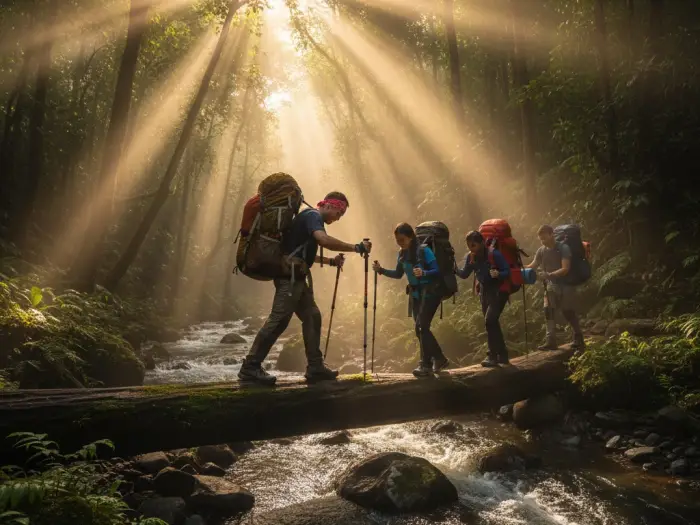
⏰ 6. Sample Itinerary – What to Expect on the Trail
Climbing Mount Apo takes 2 to 4 days, depending on your trail and pace. The Kapatagan–Kidapawan traverse is the most popular route because it offers the best of both worlds — scenic grasslands, volcanic boulders, and a forest descent.
Here’s a sample 3-day / 2-night itinerary for a typical guided climb:
| Day / Time | Activity | Details |
|---|---|---|
| Day 1 (Morning) | Travel from Davao to Kapatagan jump-off | Registration, orientation, and gear check |
| Day 1 (Afternoon) | Start trek to Camp 1 | 4–5 hours of forest and grassland hike |
| Day 1 (Evening) | Arrive at Camp 1 | Dinner, early lights out (cold night) |
| Day 2 (Early Morning) | Resume hike to Boulder Section | Challenging ascent through rocky terrain and sulfur vents |
| Day 2 (Noon) | Reach summit (2,954 MASL) | Rest, photos, and lunch at the peak |
| Day 2 (Afternoon) | Descend to Lake Venado campsite | 2–3 hours trek, enjoy the lake view |
| Day 2 (Evening) | Camp by Lake Venado | Dinner and group socials under the stars |
| Day 3 (Morning) | Continue descent via Kidapawan Trail | Long forest trek down to exit point |
| Day 3 (Afternoon) | Arrive at Kidapawan exit | Wash-up, certificate claiming, travel back to Davao |
Trail Highlights
-
Boulders Section: The most iconic part of the climb — you’ll trek across volcanic rocks and steaming vents that make you feel like walking on another planet.
-
Lake Venado: A breathtaking crater lake at 2,200 meters, often covered in mist. It’s one of the highest lakes in the Philippines.
-
Summit View: From the top, you’ll see Mindanao’s mountain ranges, Davao Gulf, and the endless horizon of clouds — a once-in-a-lifetime view.
Trail Conditions
Expect mud, slippery roots, and unpredictable weather. Some sections can get windy and exposed, so pack accordingly. Always stay close to your guide, especially in fog-prone areas where visibility can drop to near zero.
Traveler’s Move
At the summit, the wind can be harsh, and the temperature drops fast after sunrise. Bring a light down jacket or fleece and take photos quickly — your fingers will go numb before you know it.
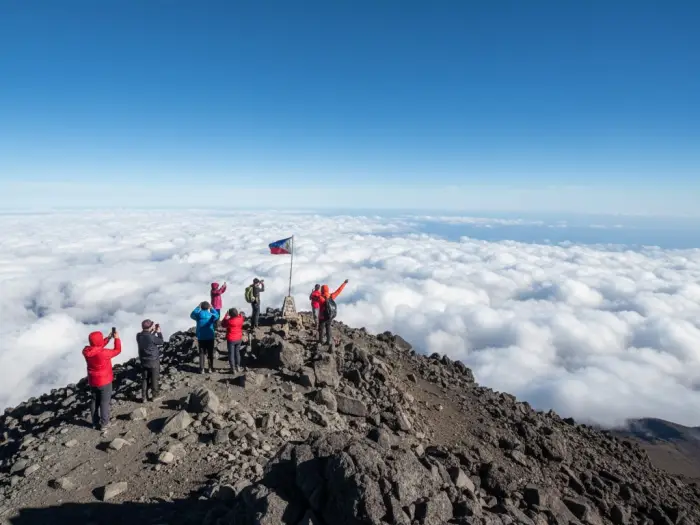
🌦️ 7. Best Time to Climb Mount Apo and Weather Tips
Mount Apo’s weather can make or break your climb. The mountain has its moods — sunny in the morning, foggy by noon, and freezing cold at night. Choosing the right season is crucial if you want clear summit views and safe trail conditions.
Best Season to Climb
The dry months of December to May are ideal for climbing. Skies are clear, the trails are firm, and the famous sunrise at the summit is almost guaranteed. Among these months, February to April are considered the “sweet spot” — not too cold, not too crowded.
Avoid climbing during the rainy season (June to October) when trails turn muddy and landslides are more likely. The park sometimes closes temporarily during strong typhoons or after heavy rains.
| Month Range | Condition | Notes |
|---|---|---|
| December – February | Cold and dry | Best for summit views |
| March – May | Hotter but stable | Peak season; book early |
| June – October | Wet and slippery | Not recommended |
| November | Transition month | Unpredictable weather |
Temperature and Conditions
At lower camps, daytime temperatures hover around 20–25°C, but near the summit, it can drop to 0–5°C especially before sunrise. Wind chill can make it feel even colder, so always bring extra thermal layers.
Weather Tips
-
Start your summit assault early — around 3 AM — to catch the best sunrise.
-
Always keep your rain gear accessible; rain can pour suddenly even during the dry months.
-
Bring a plastic cover for your backpack and electronics. Moisture builds up fast above 2,000 MASL.
Traveler’s Move
If you want both comfort and clear skies, plan your climb after Holy Week. The weather is perfect, and the crowds have thinned — giving you more peace on the trail and at the summit.
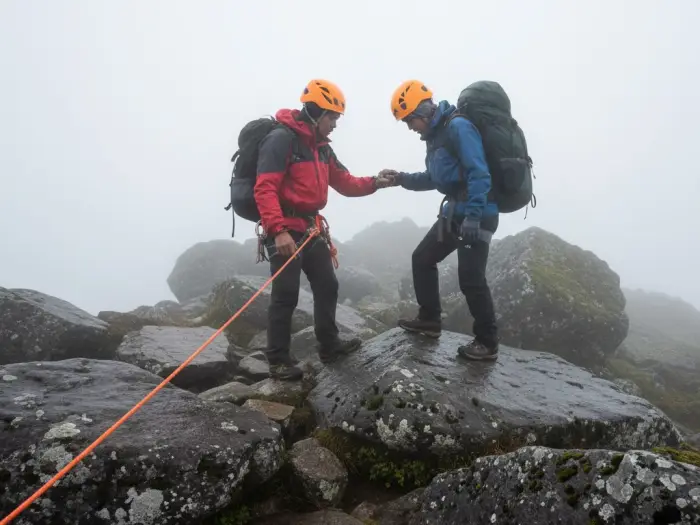
⚠️ 8. Safety Guidelines and Common Hazards on Mount Apo
Climbing Mount Apo is an unforgettable experience — but it also demands respect. Between high altitude, steep terrain, and unpredictable weather, safety should always come first. Even experienced hikers can get caught off guard if they underestimate the mountain.
Common Hazards to Watch Out For
| Hazard | What It Means | How to Handle It |
|---|---|---|
| Altitude sickness | Dizziness, nausea, or headache at high elevation | Rest, hydrate, descend if symptoms worsen |
| Sudden weather changes | Rain or fog rolling in unexpectedly | Pack a poncho and keep warm layers ready |
| Slippery trails | Especially in mossy forests and rivers | Wear shoes with good traction, use trekking poles |
| Dehydration | Long hours of hiking under the sun | Drink small amounts frequently, not all at once |
| Fatigue | Overexertion from fast pacing or heavy loads | Take breaks, eat energy food, and pace yourself |
Altitude Tips
Mount Apo’s summit reaches nearly 3,000 meters, where oxygen levels are lower. If you start feeling dizzy, slow down your pace and take deeper breaths. For sensitive climbers, bringing altitude medication like Diamox (after doctor’s advice) can help.
Wildlife and Environmental Safety
You might encounter wild animals or insects — monkeys, snakes, or leeches in wetter months. Don’t provoke them or leave food exposed. Keep noise low, and follow Leave No Trace principles.
During the Climb
-
Stay behind your guide and follow instructions strictly.
-
Never separate from your group, especially in foggy sections.
-
Use your headlamp properly at night; trails can be uneven.
-
Keep your hands free — avoid holding gadgets while hiking.
Emergency Contacts
Each trailhead (Kapatagan, Sibulan, Kidapawan) has tourism or rescue teams on standby. Guides carry radios or phones for coordination, but signal drops near the summit, so plan ahead.
Traveler’s Move
Don’t rush to the top. The climb isn’t a race — it’s about reaching safely. Always listen to your body; “buwis-buhay” moments make for great stories, but not great endings.
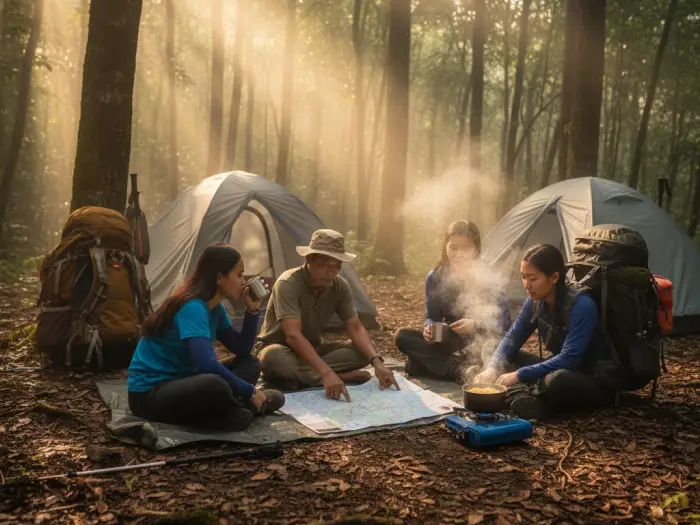
💰 9. Budget Breakdown – Guided Tour vs. DIY Mount Apo Climb
Climbing Mount Apo can be as affordable or as premium as you make it. Whether you’re joining a guided group or organizing your own expedition, budgeting ahead helps you avoid stress later — especially when costs pile up mid-climb.
Option 1: Guided Tour (Most Recommended for First-Timers)
Joining an organized climb from Davao or Kidapawan saves you the hassle of permits, transport, and logistics. Most packages include meals, tents, and guides, so all you have to do is show up fit and ready.
| Expense | Estimated Cost (₱) | Details |
|---|---|---|
| Round-trip van (Davao–trailhead) | 1,500–2,000 | Usually part of the package |
| Permits and environmental fees | 500–800 | Included in group rate |
| Guide and porter | 1,000–1,500 | Shared among 5 climbers |
| Food and water | 500–800 | Provided by tour or shared |
| Gear rental (tent, sleeping bag, stove) | 400–600 | Optional add-ons |
| Total (package) | ₱4,000–₱5,500 | Convenient and beginner-friendly |
Option 2: DIY Climb (For Experienced Hikers)
If you prefer flexibility and already own gear, a DIY Mount Apo climb gives you more control over pace and budget. You’ll handle permits, guides, and logistics yourself.
| Expense | Estimated Cost (₱) | Details |
|---|---|---|
| Bus to Davao (RT) | 1,500–2,000 | From Manila or Mindanao cities |
| Local transport to trailhead | 500–800 | Van or habal-habal ride |
| Permit and fees | 700–1,000 | Paid directly to MANP office |
| Guide and porter | 1,000–1,500 | Required for all climbers |
| Food, water, and supplies | 600–800 | Bring or buy from Davao |
| Total (DIY group of 5) | ₱4,000–₱6,000 | Slightly cheaper, more flexible |
Budget Move
If you’re traveling solo or in pairs, joining a small guided climb (8–10 people) is the best balance between cost and convenience. You’ll save on permits and transport while still getting the guidance you need for your first ascent.
Optional Add-ons
-
Mount Apo souvenir shirt or patch – ₱200–₱300
-
Hot shower at exit point – ₱50–₱100
-
Post-climb meal (Kidapawan or Digos) – ₱150–₱250
A climb this epic deserves proper preparation — and a little reward after. Nothing beats that first silog meal after three days of mountain life.
🌱 10. Responsible Climbing – Leave No Trace on Mount Apo
Mount Apo isn’t just the Philippines’ highest peak — it’s also a sacred place for the Bagobo, Manobo, and other Lumad tribes who live around its base. For them, this mountain is home to spirits, ancestors, and the life that sustains their communities. As visitors, climbers are expected to respect both nature and culture — and that starts with responsible hiking.
Leave No Trace Principles
| Principle | What It Means for Mount Apo Climbers |
|---|---|
| Plan Ahead and Prepare | Register, secure permits, and bring only what you need. |
| Travel and Camp on Durable Surfaces | Stick to existing trails and campsites — no shortcuts. |
| Dispose of Waste Properly | Bring all trash back down, including tissue and wrappers. |
| Leave What You Find | Don’t collect rocks, plants, or anything from the mountain. |
| Minimize Campfire Impact | Bonfires are banned; use portable stoves for cooking. |
| Respect Wildlife | Don’t feed monkeys or disturb natural habitats. |
| Be Considerate of Other Visitors | Keep noise low, especially at campsites. |
Cultural Respect
Before starting your climb, guides often say a short prayer or ritual to honor the mountain’s spirits. Join quietly — it’s a gesture of respect, not religion. Some areas of Apo are considered off-limits for bathing or shouting, so always listen to your guide.
Environmental Reminder
Mount Apo has faced forest fires and trash problems in the past. Every candy wrapper or plastic left behind hurts the ecosystem. Climbers now practice “zero waste hiking,” carrying reusable containers and cleaning up even trash that isn’t theirs.
Traveler’s Move
Bring an extra eco-bag or mesh sack to collect small litter along the trail. You’ll be surprised how much difference one hiker can make. And when you descend, leave the mountain a little cleaner than you found it — that’s how Apo stays majestic for generations of climbers to come.
Because at the end of every climb, the real victory isn’t reaching the summit — it’s leaving nothing behind but footprints.
❓ FAQs About Mount Apo Climb Guide for First-Timers
-
Where is Mount Apo located in the Philippines?
Mount Apo stands between Davao del Sur and North Cotabato in Mindanao. It’s the highest mountain in the Philippines at 2,954 meters above sea level. -
How difficult is the Mount Apo climb for beginners?
The climb is rated moderate to hard (6–7/9) depending on the trail. The Kapatagan Trail is the easiest route for first-timers joining guided tours. -
How many days does it take to climb Mount Apo?
Most climbers complete the Mount Apo overnight trek in 2–4 days, depending on fitness and route. The Kapatagan–Kidapawan traverse is the most popular 3-day itinerary. -
When is the best time to climb Mount Apo?
The best months are December to May, especially February to April for clear skies and a stable weather window to enjoy sunrise at the summit. -
Do I need a guide or permit to climb Mount Apo?
Yes. All hikers must secure a permit from the Mount Apo Natural Park office and hire an accredited local guide — it’s mandatory for safety and conservation. -
What should I pack for a Mount Apo climb?
Bring layered clothing, a 0°C sleeping bag, waterproof shoes, rain gear, headlamp, and trail food. This Mount Apo climb preparation list is essential for cold nights and long hikes. -
How much is the budget for a Mount Apo guided climb?
Expect to spend ₱4,000–₱5,500 for a guided tour that covers transport, permits, meals, and tents. DIY climbers can manage around the same cost when traveling in groups. -
What are the main Mount Apo trails?
The major routes are Kapatagan, Sibulan, Kidapawan, and Bongolanon Trails. Each offers different views — from mossy forests to volcanic boulder fields. -
What is the temperature like on Mount Apo?
Daytime temps average 20–25°C, but summit temperatures can drop to 0–5°C before sunrise. Thermal wear is a must for overnight climbs. -
Is it safe to climb Mount Apo today?
Yes, Mount Apo is open and safe for climbing with proper permits and guides. Always check DENR or MANP-PAMB advisories for weather-related closures before your trip.
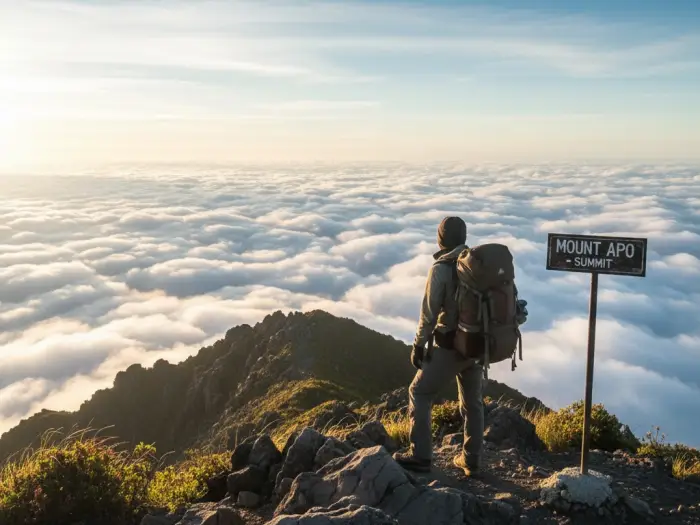
🌤️ Standing Tall at the Roof of the Philippines
Climbing Mount Apo isn’t just about bragging rights — it’s about discovering how far your determination can take you. Every muddy step, every sore muscle, and every freezing night at Lake Venado teaches you something about patience and grit.
At the summit, as you watch the sun rise above the sea of clouds, you’ll realize this isn’t just a mountain — it’s a mirror of your own resilience. You faced your limits, one breath and one step at a time, until all that’s left is pride and peace.
For many Filipinos, Apo isn’t just the highest point on the map — it’s a reminder that greatness doesn’t always look like grand victories. Sometimes, it’s waking up before dawn, sharing coffee with strangers-turned-friends, and standing on top of the world knowing you earned every moment of it.
When you finally descend, tired but smiling, take one last look at the peak and whisper a quiet salamat. Not just for the view — but for the strength you found up there.
Because truth is, you didn’t just conquered Mount Apo.
You conquered yourself.



